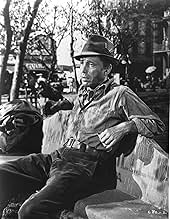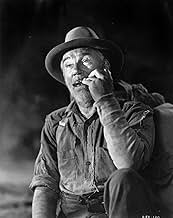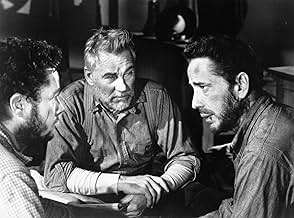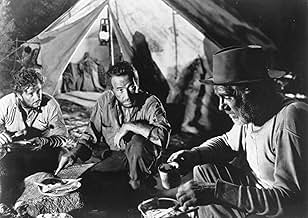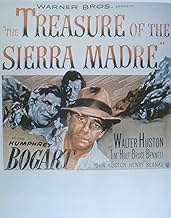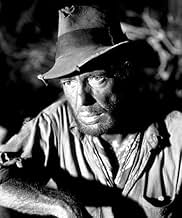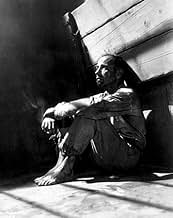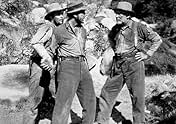Messico. Fred, senza soldi e senza lavoro conosce un vecchio cercatore d'oro e, affascinato dai suoi racconti, lo convince a partire per la Sierra Madre. A loro si unisce un altro giovane co... Leggi tuttoMessico. Fred, senza soldi e senza lavoro conosce un vecchio cercatore d'oro e, affascinato dai suoi racconti, lo convince a partire per la Sierra Madre. A loro si unisce un altro giovane compagno. I tre riescono a trovare l'oro; ma l'avidità li renderà spietati.Messico. Fred, senza soldi e senza lavoro conosce un vecchio cercatore d'oro e, affascinato dai suoi racconti, lo convince a partire per la Sierra Madre. A loro si unisce un altro giovane compagno. I tre riescono a trovare l'oro; ma l'avidità li renderà spietati.
- Regia
- Sceneggiatura
- Star
- Vincitore di 3 Oscar
- 18 vittorie e 5 candidature totali
Barton MacLane
- Pat McCormick
- (as Barton Mac Lane)
Arturo Soto Rangel
- Presidente
- (as A. Soto Rangel)
Manuel Dondé
- El Jefe
- (as Manuel Donde)
José Torvay
- Pablo
- (as Jose Torvay)
Robert Blake
- Mexican Boy Selling Lottery Tickets
- (non citato nei titoli originali)
Guillermo Calles
- Mexican Storeowner
- (non citato nei titoli originali)
Roberto Cañedo
- Mexican Lieutenant
- (non citato nei titoli originali)
Spencer Chan
- Proprietor
- (non citato nei titoli originali)
Jacqueline Dalya
- Flashy Girl
- (non citato nei titoli originali)
Ralph Dunn
- Flophouse Bum
- (non citato nei titoli originali)
Ernesto Escoto
- Mexican Bandit
- (non citato nei titoli originali)
Pat Flaherty
- Customer in Bar Who Warns Curtin and Dobbs about Pat McCormick
- (non citato nei titoli originali)
Riepilogo
Reviewers say 'The Treasure of the Sierra Madre' is a critically acclaimed classic, lauded for its profound examination of greed, betrayal, and human nature. John Huston's direction and screenplay, alongside exceptional performances by Humphrey Bogart, Walter Huston, and Tim Holt, are often celebrated. The film's authentic atmosphere, intricate character studies, and moral complexities deeply resonate. Although some critique its pacing and subplots, most regard it as a timeless masterpiece noted for its psychological depth and thematic richness.
Recensioni in evidenza
Tampico sets the scene for the start of speculation, Fred C. Dobbs is out of cash and his luck is in cessation, but an encounter in flophouse, and big dreams emerge and arouse, as a plan is born with Howard, and a fellow who's called Curtin. Into hills laden with gold, our companions then embark, finding seams that come alive with golden riches to impart, building up substantial fortune, thinking soon they will be tycoons, but there's one who's trust is waning and has sores that start to smart. The journey back becomes a challenge to them all, as one by one the group is scattered, battered, stalled, will their work be well rewarded, will endeavours all be thwarted, either way, you will be engaged, and quite possibly enthralled.
Bogarts best performance.
Bogarts best performance.
Some movies have certain scenes in them that hold the viewers interest more than others. However every single scene in this film holds the viewers interest. There is never a dull or lagging moment. Three down and outers who at one time in their lives were maybe up and comers strike out in search of a fortune or at least enough to live better than they have been.
While Humphrey Bogart gives a superb performance it is Walter Huston who turns in the greatest performance as the old prospector Howard. The scene in the Indian village where he helps to restore a comatose child is one of the most touching in all of film history and is done virtually without any dialog. Mexican character actor Alfonso Bedoya of course steals all the scenes he appears in and delivers his classic "Stinking Badges" line. (what person would dress up as a Bandito for a costume party and not want to look exactly like Bedoya's Gold Hat character?) This film probably should have been a little higher on AFI's top 100. A must see!
While Humphrey Bogart gives a superb performance it is Walter Huston who turns in the greatest performance as the old prospector Howard. The scene in the Indian village where he helps to restore a comatose child is one of the most touching in all of film history and is done virtually without any dialog. Mexican character actor Alfonso Bedoya of course steals all the scenes he appears in and delivers his classic "Stinking Badges" line. (what person would dress up as a Bandito for a costume party and not want to look exactly like Bedoya's Gold Hat character?) This film probably should have been a little higher on AFI's top 100. A must see!
Two penniless Americans (Humphrey Bogart and Tim Holt) during the 1920s in Mexico join with an old-timer (Walter Huston, the director's father) to prospect for gold. The old-timer accurately predicts trouble, but is willing to go anyway. The film is fictional, but presents a very realistic scenario: By the 1920s the violence of the Mexican Revolution had largely subsided, although scattered gangs of bandits continued to terrorize the countryside. The newly established post-revolution government relied on the effective, but ruthless, Federal Police, commonly known as the Federales, to patrol remote areas and dispose of the bandits. Foreigners, like the three American prospectors, were at very real risk of being killed by the bandits if their paths crossed. The bandits, likewise, were given little more than a "last cigarette" by the army units after capture, even having to dig their own graves first.
The film shows the Americans doing just about anything for money: drilling oil, digging for gold, begging and more. And once gold comes into the picture, the men who once claimed they were not greedy see things differently. Bogart actually goes mad, after he gets greedy and paranoid... during which he encounters a gila monster! The most memorable scene of this film involves the bandits, who don't need any "stinking badges". While the line is much more quotable in "Blazing Saddles", we couldn't have "Blazing Saddles" (or "UHF") without this film... just about everyone, even those who never saw or heard of "Sierra Madre", knows the badges line.
Humphrey Bogart's best film is probably "Casablanca", but this one features him in a nice, rough exterior. Yes, sometimes leading men have beards and are covered in dirt. Pretty boys do not stay pretty boys after digging in the hills, or at least that wouldn't be realistic. This film does a fine job trying to "keep it real", so we have to commend Huston not only on his directing, but his wonderful location scouting.
The film shows the Americans doing just about anything for money: drilling oil, digging for gold, begging and more. And once gold comes into the picture, the men who once claimed they were not greedy see things differently. Bogart actually goes mad, after he gets greedy and paranoid... during which he encounters a gila monster! The most memorable scene of this film involves the bandits, who don't need any "stinking badges". While the line is much more quotable in "Blazing Saddles", we couldn't have "Blazing Saddles" (or "UHF") without this film... just about everyone, even those who never saw or heard of "Sierra Madre", knows the badges line.
Humphrey Bogart's best film is probably "Casablanca", but this one features him in a nice, rough exterior. Yes, sometimes leading men have beards and are covered in dirt. Pretty boys do not stay pretty boys after digging in the hills, or at least that wouldn't be realistic. This film does a fine job trying to "keep it real", so we have to commend Huston not only on his directing, but his wonderful location scouting.
Having had his day as an idolized star and romantic leading man, it was now time for Bogart to get down to the serious business of acting
For eighteen years it had usually been Bogart playing Bogart in various shadings
Now that Bogart was gone and in his place was an older and far less romantic figure, one who found new challenges and was able to meet most of them successfully
This new phase of his continued growth began with a story of three men in search of gold
Although "The Treasure of the Sierra Madre" is indisputably one of Bogart's best films, it was co-star Walter Huston who won an Academy Award as did the movie's director and scenarist, John Huston
Based on a novel by the mysterious B. Traven, the film told a riveting tale which explored the degenerative effects of encroaching greed, distrust, and hatred on three prospectors who team up to search for gold in Mexico
Bogart's Fred C. Dobbs was an amazingly complex creation whose slow disintegration into paranoia was brilliant1y managed on camera He is a born loser with no potential for change in sight Suspicious, unfeeling, savage, and easily corruptible, he seems clearly destined for a tragic fate almost from our first meeting with him
Tim Holt was also excellent as Bob Curtin, a man who, like Bogart, is tempted but whose conscience will not permit him to exercise his baser desires. (He could have let Bogart die in a cave-in, but saved him instead.) Young, impressionable, and unprepared, he has never seen the likes of a Fred C. Dobbs and he finds himself overwhelmed and uncertain as to how he will cope with Dobbs's rage and greed
However, it is the director's father, Walter Huston, who literally stole the picture from both Bogart and Holt as he played Howard, a wise old toothless codger who knew all along what would happen and took it all in stride, kicking up his heels and having a marvelous time Life can't surprise him any more He's already had successes and failures enough for one lifetime Like a faithful dog, he's along for the thrill of the hunt, and should there be another pot of gold at the end of this rainbow, well, that's just a bonus
It is mainly the interaction of these three men from their first meeting and uneasy partnership through their final confrontation that made "The Treasure of the Sierra Madre" one of Warner Brothers' triumphs of the forties
Although "The Treasure of the Sierra Madre" is indisputably one of Bogart's best films, it was co-star Walter Huston who won an Academy Award as did the movie's director and scenarist, John Huston
Based on a novel by the mysterious B. Traven, the film told a riveting tale which explored the degenerative effects of encroaching greed, distrust, and hatred on three prospectors who team up to search for gold in Mexico
Bogart's Fred C. Dobbs was an amazingly complex creation whose slow disintegration into paranoia was brilliant1y managed on camera He is a born loser with no potential for change in sight Suspicious, unfeeling, savage, and easily corruptible, he seems clearly destined for a tragic fate almost from our first meeting with him
Tim Holt was also excellent as Bob Curtin, a man who, like Bogart, is tempted but whose conscience will not permit him to exercise his baser desires. (He could have let Bogart die in a cave-in, but saved him instead.) Young, impressionable, and unprepared, he has never seen the likes of a Fred C. Dobbs and he finds himself overwhelmed and uncertain as to how he will cope with Dobbs's rage and greed
However, it is the director's father, Walter Huston, who literally stole the picture from both Bogart and Holt as he played Howard, a wise old toothless codger who knew all along what would happen and took it all in stride, kicking up his heels and having a marvelous time Life can't surprise him any more He's already had successes and failures enough for one lifetime Like a faithful dog, he's along for the thrill of the hunt, and should there be another pot of gold at the end of this rainbow, well, that's just a bonus
It is mainly the interaction of these three men from their first meeting and uneasy partnership through their final confrontation that made "The Treasure of the Sierra Madre" one of Warner Brothers' triumphs of the forties
The Treasure of the Sierra Madre (1948)
This is a weirdly contemporary film. I mean, it's certainly set in the past, and it's made in the heyday of Hollywood genius top to bottom which is long gone. But because it's about this old time and about raw black and white issues (often), the film and the filming are really appropriate. The whole thing just fits, and beautifully.
And I mean beautiful. As rugged as it all is--the landscape as well as the beards, all very real--the movie is lyrically filmed. The story is told with visual clarity. And the script, speaking of story, is sophisticated and believable. In all, under the direction of legend John Huston, this is a spot on terrific movie.
Of course, there are two actors who are just amazing in their roles (and a third, Tim Holt, who is just fine, if not stellar). I mean of course Walter Huston, who nearly steals the show in every scene. He's a character, but not a caricature. His wisdom--real wisdom, based on smart observation over decades of experience--is sterling. Great stuff, well put. And of course he's the father of the director, which is a fun, and slightly Freudian twist. He gives one of the great performances of the decade.
Humphrey Bogart is not far behind, actually. If you like him in Maltese Falcon or Casablanca, you'll be surprised at first by the scruffy, raw character played here. But it's clear-headed, brilliantly delivered Bogart all the way, and a joy to watch him really act. See it for him, too.
Then there is the story itself, which is as important now as ever. That is, what matters in life? And what is the price to pay to get it? It's all rather bold and emotional even though it's delivered by some rough guys out of money prospecting in the wilderness of Mexico.
Are there downsides here? I suppose. You certainly can wonder about the way the Mexicans--good ones and banditos both--are portrayed. I think it's not bad, tinged with clichés, of course, but in Spanish without translation or stilted half-English, so it's the real thing. And no subtitles. Nicely done for an early Hollywood affair. Huston, the son, the director, if you don't know, is famous for doing things raw and right and slightly off the charts. He is making a commercial film, to be sure, but it has many small aspects that are just not pandering to anyone. This makes it work.
I'm sure to some this is a masterpiece. I'm giving that some thought. See it.
This is a weirdly contemporary film. I mean, it's certainly set in the past, and it's made in the heyday of Hollywood genius top to bottom which is long gone. But because it's about this old time and about raw black and white issues (often), the film and the filming are really appropriate. The whole thing just fits, and beautifully.
And I mean beautiful. As rugged as it all is--the landscape as well as the beards, all very real--the movie is lyrically filmed. The story is told with visual clarity. And the script, speaking of story, is sophisticated and believable. In all, under the direction of legend John Huston, this is a spot on terrific movie.
Of course, there are two actors who are just amazing in their roles (and a third, Tim Holt, who is just fine, if not stellar). I mean of course Walter Huston, who nearly steals the show in every scene. He's a character, but not a caricature. His wisdom--real wisdom, based on smart observation over decades of experience--is sterling. Great stuff, well put. And of course he's the father of the director, which is a fun, and slightly Freudian twist. He gives one of the great performances of the decade.
Humphrey Bogart is not far behind, actually. If you like him in Maltese Falcon or Casablanca, you'll be surprised at first by the scruffy, raw character played here. But it's clear-headed, brilliantly delivered Bogart all the way, and a joy to watch him really act. See it for him, too.
Then there is the story itself, which is as important now as ever. That is, what matters in life? And what is the price to pay to get it? It's all rather bold and emotional even though it's delivered by some rough guys out of money prospecting in the wilderness of Mexico.
Are there downsides here? I suppose. You certainly can wonder about the way the Mexicans--good ones and banditos both--are portrayed. I think it's not bad, tinged with clichés, of course, but in Spanish without translation or stilted half-English, so it's the real thing. And no subtitles. Nicely done for an early Hollywood affair. Huston, the son, the director, if you don't know, is famous for doing things raw and right and slightly off the charts. He is making a commercial film, to be sure, but it has many small aspects that are just not pandering to anyone. This makes it work.
I'm sure to some this is a masterpiece. I'm giving that some thought. See it.
Lo sapevi?
- QuizJohn Huston stated that working with his father on this picture and his dad's subsequent Oscar win were among the favorite moments of his life.
- BlooperAlthough set in the 1920s, many of the cars on the streets of Tampico are of 1930s and 1940s vintage; likewise, women, when prominently seen, are groomed and dressed strictly in the style of the 1940s.
- ConnessioniFeatured in The Screen Writer (1950)
- Colonne sonoreBelieve Me If All Those Endearing Young Charms
(1808) (uncredited)
Music traditional
Played on harmonica by Walter Huston
I più visti
Accedi per valutare e creare un elenco di titoli salvati per ottenere consigli personalizzati
Dettagli
- Data di uscita
- Paese di origine
- Lingue
- Celebre anche come
- El tesoro de la Sierra Madre
- Luoghi delle riprese
- Kernville, California, Stati Uniti(Kelly's Rainbow Mine)
- Azienda produttrice
- Vedi altri crediti dell’azienda su IMDbPro
Botteghino
- Budget
- 3.000.000 USD (previsto)
- Lordo Stati Uniti e Canada
- 5.014.000 USD
- Fine settimana di apertura Stati Uniti e Canada
- 144.074 USD
- 14 gen 2018
- Lordo in tutto il mondo
- 5.014.124 USD
- Tempo di esecuzione
- 2h 6min(126 min)
- Colore
- Proporzioni
- 1.37 : 1
Contribuisci a questa pagina
Suggerisci una modifica o aggiungi i contenuti mancanti


